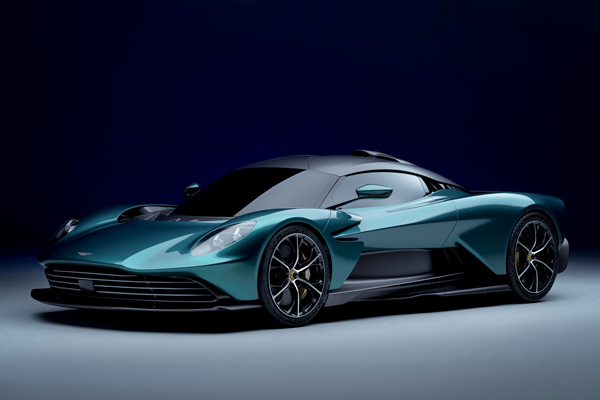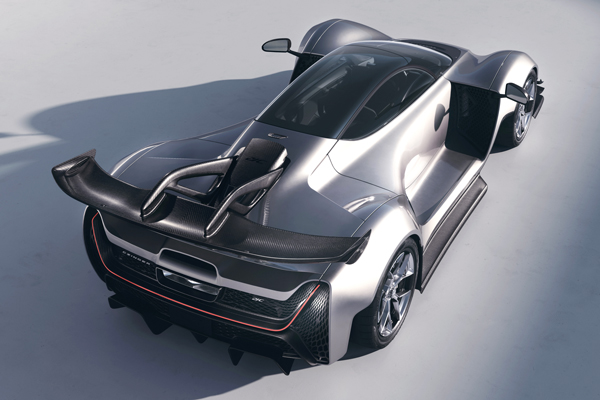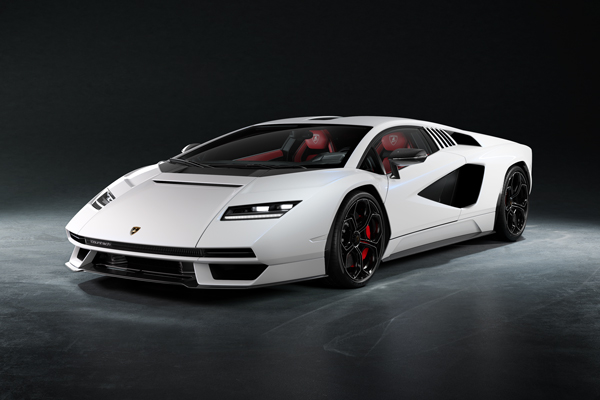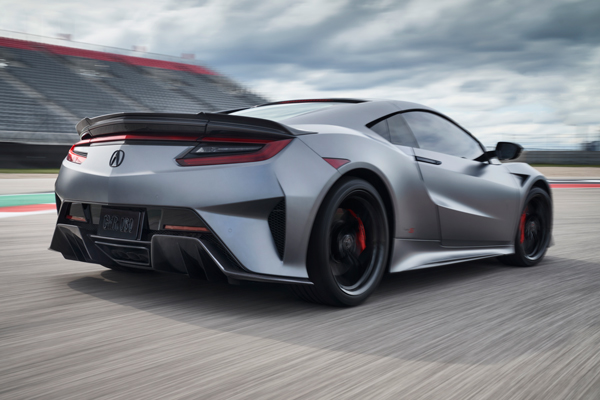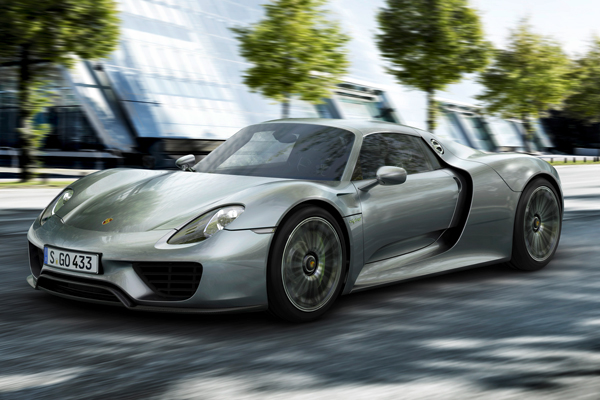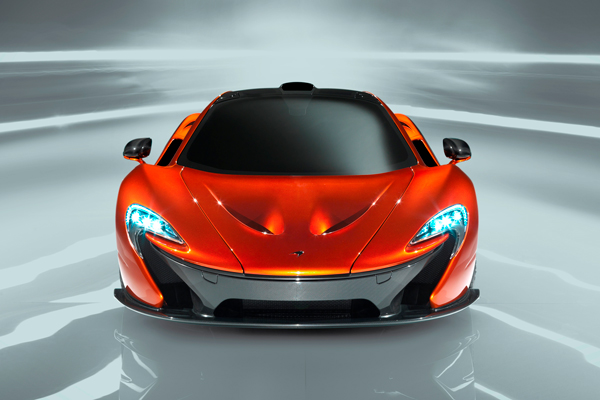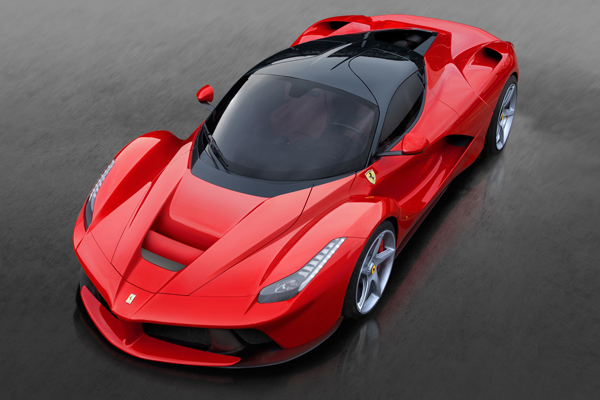Amped Up | Supercars and the Hybrid Revolution
Back in the July edition of Motor Trader, we ran a feature on the rise of the all-electric supercar (click HERE to view that edition of the magazine).
Those pure battery-powered machines are remarkable. They are incredibly quick, powerful and technologically advanced. And yet the electrification of the industry encompasses more than just the move to battery power. Hybrids, which combine internal combustion engines (ICE) with batteries and electric motors, are part of the automotive electrical revolution too.
Like pure battery technology, hybrid tech allows for incredibly fuel-efficient transport and exceptionally high performance. In fact, at the very highest level, hybrids pair the very best of both ICE and electric battery and motor technology to deliver performance that rivals that of the fastest all-electric supercars.
Take Formula One race cars, for example. Perhaps the pinnacle of powertrain engineering development, the cars of the world’s leading racing category have been powered by hybrid systems since 2014, combining a turbocharged 1.6-litre V6 engine with Motor Generator Units (MGU) that harness energy via braking and exhaust heat. Stored energy recovered via braking is used via the MGU-K to power an electric motor to assist the ICE, while stored energy from the exhaust is used by the MGU-H to assist the turbocharger and eliminate turbo lag.
What this amounts to is a car with 745kW (1000hp) on tap and which can edge toward the 400km/h mark as a top speed and get to 100km/h in around 2.5 seconds.
This is the type of technology that is making its way into the hybrid supercars of today, and with manufacturers long having used motorsport as a testbed for technology that may trickle down to its mass-produced models, we may see it in more regular (and affordable) models at some point.
The past few months have seen a handful of hybrid supercars make their debuts with Ferrari, Aston Martin, and Lamborghini all unveiling new models. And so, this month, we decided to take a closer look at some of these amazing hybrid monsters. They are incredible.
Ferrari SF90 Spider & 296 GTB Hybrid
A few weeks ago, Australia welcomed two absolute rippers from Ferrari into the country – the SF90 Spider and the 296 GTB.
Motor Trader had a chance to see these brand-new supercars when they made an appearance at the Gold Coast Ferrari (SF90 Spider) and Brisbane Ferrari (296 GTB) dealerships and we can confirm that, in the flesh, these cars are just as stunning as they are in the images you see here.
And while we didn’t get a chance to drive them (we wish!), sitting in them and being able to check out the tech, trim and their overall style just confirmed that these are cars from the very top of the top drawer.
The 296 GTB pairs a V6 engine with an electric motor and 7.45 kWh battery set-up – the first time Ferrari has done so on a road car.
And the combination delivers thumping performance. The 2.9-litre V6 twin-turbo engine pumps out 488kW and in combination with that 122kW electric motor, power jumps up to 610Kw and 740Nm. That power is directed to the rear wheels through an eight-speed dual clutch transmission.
The company claims 100km/h can be reached in just 2.9 seconds, and 200km/h in 7.3 seconds. Top speed is over 330km/h. Outstanding stuff.
The electric part of the powertrain is powerful enough, Ferrari says, for a pure-electric range of 25km.
Even with the additional battery and electric motor components, the use of innovative materials and a smaller engine has kept the 296 GTB pretty trim at 1479kg, and there is, of course, plenty of aerodynamic and technical and engineering innovation going on to make the car an outstanding drive.
There’s a beefed-up version of the 296 GTB on offer too, with customers seeking to get even more out of the car able to select the Assetto Fiorano package which is even trimmer than the standard version thanks to extensive use of carbon fibre components, and which gets even more extreme handling thanks to racing derived suspension.
The SF90 Spider, meanwhile, is Ferrari’s most powerful series-production supercar. It is the convertible version of the company’s SF90 Stradale and is the first hybrid in the Ferrari stable with a retractable hard top.
Power comes from a 574kW, 4-litre turbocharged V8 paired with three electric motors – two at the front and one at the rear – which together pump out some 735kW.
Performance is, not surprisingly, outstanding with 100km/h reached in a blistering 2.5 seconds and top speed topping out at 340km/h.
As with the 296 GTB, there is an Assetto Fiorano pack for the SF90 Spider which offers performance upgrades and the adoption of materials such as carbon fibre and titanium.
On the inside of both the 296 GTB and the SF90 Spider, things are high-tech and futuristic. The interior is all of the highest quality, of course, and the digital instrumentation is clear, well designed, and displays crisp and sharp on a large high-definition screen. There’s another, slim screen for the passenger which can control certain infotainment features.
On both models, there is an eManettino switch that allows the driver to flick between four different modes including eDrive (which puts the car into electric-only drive), Hybrid (optimising system efficiency), and Qualify (for maximum power).
No doubt you’ll have to part with a fair chunk of change to buy either of these cars but, if you can do that, you’ll surely be piloting one of the best supercars money
can buy.
VIDEO: FERRARI SF90 SPIDER
Aston Martin Valhalla
The Valhalla is a mid-engined hybrid supercar, due in 2023, that has at its heart a PHEV powertrain that features a whopping 552kW 4-litre twin-turbo V8, developed in conjunction with Mercedes AMG, paired with dual electric motors – one on the front axis and one on the rear axis – that deliver an extra 150kW.
Performance is eye-watering, with Aston Martin claiming that when the Valhalla is running at full steam with all 700KW available, it can reach a top speed of 330km/h and sprint from 0-100km/h in 2.5 seconds.
When driven in EV mode, battery power is directed to the front axle and the car can reach 130km/h and has a zero-emission range of 15km.
In other driving modes, battery power is split between front and rear axles and, in certain situations, 100 per cent of battery power can be sent to the rear, combining with the V8 which sends its power to the rear, for maximum performance.
Completing the powertrain is an 8-speed DCT transmission. Aston Martin says the paddle-shift gearbox has been developed specifically for the hybrid era, and features e-reverse (which utilises the PHEV’s electric motors). The transmission also features an Electronic Limited-Slip Differential (E-Diff) on the rear axle.
The Valhalla is built around a carbon fibre tub and sports high-performance Carbon Ceramic Matrix brakes and bespoke Michelin tyres – 20-inch at the front and 21-inch at the rear. The supercar also employs a combination of active aerodynamic surfaces and controlled underbody airflow. Such is the design here, that it can generate 600kg of downforce at 240km/h.
On the inside, there’s a pared back cockpit design, a new HMI (Human Machine Interface) system that features a central touchscreen display which incorporates Apple CarPlay and Android Auto, adjustable pedals and steering column, and raised footwells for a low hip-to-heel seating position – a design inspired by F1 cars.
There’s full LED Matrix headlights with adaptive functionality and high-beam assist, Dual Zone Air Conditioning and a suite of Advanced Driver Assistance Systems, including Auto Emergency Braking, Forward Collision Warning, Active Cruise Control, Blind Spot Monitoring and Rear View Parking Camera.
VIDEO: ASTON MARTIN VALHALLA
Czinger 21C
Earlier this year, Czinger, the California-based start-up hypercar maker, revealed what it says is the final production version of its first car – the absolutely epic Czinger 21C.
First unveiled in 2020, the 21C is partly manufactured using 3D printing (aka additive manufacturing) technology and just by the looks of the thing it’s easy to see its performance is going to be awe-inspiring.
The sleek, lightweight (1240kg) machine is powered by an in-house developed 2.88-litre, twin-turbo V8 located midships, partnered with an 800V drive system with two high-output electric motors, and a seven-speed sequential transaxle gearbox with a hydraulically actuated multi-plate clutch.
There’s all-wheel drive – with the electric motors driving the front wheels – and the combined power from the hybrid system is a blistering 932kW. There is, apparently, an upgrade option that can beef this up to 1000kW.
The 2.8kWh battery pack is charged during operation both through regenerative braking and a Motor Generator Unit (MGU) using a gear drive that is attached to the V8.
Top speed is, Czinger says, up to 450km/h when the car is in its optional low drag vmax configuration. 0 to 100km/h arrives in an jaw-dropping 1.9 seconds. 400km/h is reached in a snip over 21 seconds! The design of the 21C allows for 638kg of downforce at 161km/h and a hefty 2,552kg at 322km/h.
In July, Czinger showed off the C21’s speed chops by setting a lap record of 1:25:44 at the Laguna Seca race circuit in California. That time beat the previous record, set by the McLaren Senna, by more than two seconds.
80 Czinger 21C units are slated for production.
VIDEO: CZINGER 21C AT LAGUNA SECA
Lamborghini Countach
We talked about the new Lamborghini Countach – the LPI 800-4 – in last month’s Motor Trader, but we can’t do a feature on hybrid supercars without mentioning it again.
It’s a real beauty, and underneath that beautiful skin is a hybrid system that pairs a 574kW, V12 engine with a 25kW electric motor and permanent four-wheel-drive.
The V12 6.5-litre engine is combined with the 48-volt e-motor mounted directly on the gearbox, and the e-motor is powered by a supercapacitor that Lamborghini says provides three times more power compared to a lithium-ion battery of the same weight.
Performance is, as you’d expect from a Lambo, rather excellent with 100km/h reached in 2.8 seconds and top speed a claimed 355km/h.
The Countach has a carbon fibre monocoque chassis, and carbon fibre body panels, and there’s plenty of exterior carbon fibre features too, both inside and outside.
There’s also a photochromatic roof and, on the inside, there’s an 8.4-inch HDMI centre touchscreen that manages car controls including Connectivity systems.
The Countach LPI 800-4 sits on 20-inch (front) and 21-inch (rear) wheels fitted with carbon ceramic brake discs and Pirelli P Zero Corsa tyres.
Owners of the limited edition Countach LPI 800-4 can choose from a range of heritage exterior paint options such as Impact White, Giallo Countach and Verde Medio, and contemporary palette offers including Viola Pasifae.
Just 112 units of the Countach will be made, and deliveries to customers are expected to begin from the first quarter of 2022.
VIDEO: LAMBORGHINI UNVEILS THE NEW HYBRID COUNTACH
Mercedes-AMG Project One
In our introduction to this hybrid supercar feature, we mentioned the cutting-edge tech used in Formula One.
The Project One is as close in technology terms to an F1 car as it is possible to get in a raod car, essentially adapting a complete Formula 1 drive unit.
The 1.6-litre V6 engine is partnered with four electric motors – the MGU-K that is linked to the crankshaft; the MGU-H integrated into the turbocharger; and two 120kW motors for the front wheels. The 500kW ICE engine drives the rear wheels.
All up, the carbon fibre-bodied Project One develops more than 740kW (over 1000hp) and its performance is set to be suitably electric. Mercedes-AMG claims the car can reach 100km/h in a smidge over two seconds and has a top speed of more than 350km/h.
Its race car foundation is as clear on the inside as it is in the design and the engineering beneath the skin. A minimalist interior is, the company says, inspired by Formula
One and there are contoured bucket seats, and pedals plus an F1-style steering wheel that are adjustable. Hints of the luxury status of the Merc-AMG brand are there though, with nappa leather used for the interior trim and a large infotainment screen for all the connectivity goodies that such top-of-the-range cars must have.
275 of the Project One are to be made, and while the car has been in development for some time, pre-production models have been going through on-track testing. First deliveries are reportedly to take place next year.
Koenigsegg Gemera
The world’s first ‘Mega-GT’. That is what Koenigsegg, the Swedish supercar maker, calls the Gemera, its first four-seater car that has oodles of power, luxury and refinement. Whatever the category, the Gemera is a stunning piece of work.
The powerful hybrid seats four adults comfortably with space for carry-on luggage, and despite having a focus on traveling long-range on family trips, the four-seater will, Koenigsegg claims, easily outperform most two-seat supercars.
Under that exquisite bodywork is a power system that offers 1268kW of power and 3500Nm of torque, propelling the Gemera from 0 to 100 km/h in 1.9 seconds on to a top speed of 400 km/h. That should convert to plenty of excitement to keep the kids engaged in the back!
The powertrain has three electric motors – one for each rear wheel and one on the crankshaft of the engine – that have a combined output of 800kW. On top comes 447kW and 600Nm from the 2-litre, 3-cylinder dry-sumped twin-turbo freevalve engine that the company calls the ‘Tiny Friendly Giant’ or TFG.
Freevalve? That sounds unusual and comes from the fact that the TFG has no camshaft. Instead, as Koeniggsig describes it on their website, the Freevalve system offers the ability to have independent control of the intake and exhaust valves. ‘For any engine load criteria, the timing of intake and exhaust can be independently adjusted. The system can then “decide” how to operate the valves depending on driving conditions – which combination to use in order to maximize performance, minimize fuel consumption or regulate emissions. Freevalves allows for a greater degree of control over the engine, which in turn provides significant performance and environmental benefits.’
The Gemera’s three electric motors can drive up to 300 km/h. The car has a range of up to 50km in EV mode and the engine can, apparently, run on a variety of fuels.
Features include all-wheel steering and the Gemera has a carbon fibre monocoque body, six smart airbags, stability control, traction control, ABS and an ADAS 2.5 assistant system.
A stunning interior layout includes plenty of comforts and decent usability befitting its four-person design. There are four cold and four warm cup holders, front and rear seat central infotainment displays, front and rear wireless phone chargers, Apple CarPlay, internet and Wi-Fi, exterior and interior cameras, four reading lights, memory foam heated seats, electric front seats, three climate zones and plenty more. Stunning stuff!
McLaren Artura
Earlier this year, McLaren pulled the covers off its Artura hybrid supercar.
The Artura is the first series-production, high-performance plug-in hybrid from McLaren and it would seem the company has pulled out all the stops to make it deliver on all levels.
The Artura gets its grunt by pairing a 430kW/585Nm, 3-litre twin-turbocharged V6 with a 70kW/225Nm electric motor. The ultra-compact electric motor is fully integrated within the transmission bell housing.
The combined output of 500kW and 720Nm produces performance figures of 0-100km/h in 3 seconds and a limited top speed of 330km/h.
The dual power systems are integrated via an engine disconnect clutch, driving the rear wheels via an all-new, twin-clutch transmission developed especially for the Artura. The 8-speed transmission offers no reverse gear – the electric motor achieves reverse by rotating in the opposite direction.
The electric motor is powered by a 7.4kWh battery that can also deliver a pure EV range of 30km. Top speed in EV mode is 130km/h. Plug-in capabilities allow for an 80 per cent charge in 2.5 hours.
The Artura is built on McLaren’s new MCLA (McLaren Carbon Lightweight Architecture), and the effort to keep the car’s weight low sees it come in at a trim 1,498kg.
Hybrid power and light weight also makes the Artura McLaren’s most fuel-efficient model. The company claims 5.6 litres-per-100km.
There’s a new rear suspension system and an electronically controlled differential to independently control torque moving across the rear axle.
The Artura sits on Pirelli tyres wrapping around 19-inch wheels at the front and 20-inch wheels at the back. Pirelli Cyber Tyre tech is used, which features a ‘chip’ inside each tyre generating real-time data that is relayed to the car’s stability control systems. Carbon ceramic brakes and lightweight aluminium calipers deliver on stopping power.
On the inside, there’s an all-new infotainment and connectivity system (MIS II) that includes updated versions
of McLaren’s Track Telemetry and Variable Drift Control apps.
ADAS (Advanced Driver Assistance Systems) features include Adaptive Cruise Control with Stop/Go, Lane-Departure Warning, and Road Sign Recognition. These and the infotainment features can be enhanced via over-the-air updates.
UK pricing for the Artura is £185,500 ($AU332,000).
VIDEO: ARTURA – THE FULL FORCE OF MCLAREN
Honda (Acura) NSX Type S
The first generation of Honda’s NXS appeared in 1990, and it has always been considered an excellent sports car. In August this year, the company unveiled its 2022 NSX Type S in the US (where it is known as the Acura NXS and where the car will also be built) – the last of the second-generation models.
Just 350 units of the Type S are to be built, with almost all destined for the US market.
Power for the Type S comes from a 3.5-litre twin-turbocharged V6 paired with three electric motors -a hybrid system that produces 447kW and 667Nm. One of the electric motors aids the V6 in powering the rear wheels, the other two are up front, with this Twin Motor Unit (TMU), driving the front wheels.
There’s a 9-speed DCT auto transmission and a torque-vectoring system – called Sport Hybrid Super Handling All-Wheel Drive – offering top performance. An available Lightweight Package includes Carbon Ceramic Brakes, Carbon Fibre Engine Cover and Carbon Fibre interior package for that extra sporty touch.
Performance figures aren’t published but the 2021 NSX was good for a snip over 300km/h and a 0-100km/h time of around three seconds.
There are four drive modes – Quiet, Sport, Sport+, and Track – which vary suspension calibration, performance downshifting speed, and even the sound of the car, and the NSX Type S rides on specifically developed Pirelli P Zero tyres (245/35ZR19 at the front and 305/30ZR20 at the rear) to deliver on handling and braking performance.
The NSX has always been a looker, and the Type S gets a more aggressive style that also gives some improved aerodynamics. The new nose has larger, more angular air intakes, and the rear end gets a larger diffuser that creates more downforce. The design also allows for improved air flow to the side-mounted air intakes for the intercoolers.
The interior of the Type S gets some extra features, including Alcantara headlining and embroidered Type S logo on the headrests, amongst other touches.
In the US, the NSX Type S is priced at $169,500 ($AU233,400) for the standard model and $182,500 ($AU251,290) for the Lightweight Package version.
VIDEO: ARTURA – THE FULL FORCE OF MCLAREN
The Holy Trinity
Known as the Holy Trinity of hypercars, the McLaren P1, Ferrari LaFerrari, and Porsche 918 Spyder were all limited-edition hybrid hypercars that appeared in 2013, and all three heralded a future in which hybrid power would be a serious player in the high-performance sector.
Porsche 918 Spyder
Designed and built with insight gained from the development of Porsche race cars for the 24 Hours of Le Mans, the 918 has a 4.6-litre V8 producing 453kW coupled to its hybrid module. There’s a 6.8kWh battery, a 115kW electric motor on the rear axle and a 95kW motor on the front, and combined output for the car is 652kW and 1280Nm.
Power to the rear axle is sent through a 7-speed PDK transmission (Porsche’s version of a dual-clutch transmission), and the 918 can do about 19km in pure EV mode.
In the tradition of keeping sports cars light but strong, the 918 has a subframe and monocoque made of carbon fibre reinforced polymer.
Performance is outstanding. 0-100km/h can be reached in around 2.5 seconds (though independent testing did reportedly send that time tumbling to 2.2 seconds) and top speed was a rip-snorting 345km/h. Late in 2013, Porsche sent the car out to set a time on Germany’s famous Nurburgring track and the 6 minutes 57 seconds time it posted still stands as one of the quickest laps set by a production car.
Production of the Porsche 918 Spyder ran from 2013 to 2015, and 918 units were built.
McLaren P1
Like the Porsche 918 Spyder, the McLaren P1 production ran from 2013 to 2015 and, also like the Porsche, the P1 has a twin turbocharged V8 at its heart. Unlike the Porsche, the 542kW, 3.8-litre unit is paired to a hybrid system of a 4.7kWh battery and a single electric motor that delivers 132Kw. Total grunt of 674kW and 900Nm is directed through the rear wheels.
As an innovator in the use of carbon fibre for the construction of its cars, there’s no surprise in the fact McLaren used the material heavily in the P1 – there’s a carbon fibre monocoque and cabin structure called the MonoCage – and plenty of Formula One-inspired features fed into the P1’s design. These included such elements as a Drag Reduction System, Brake Steer, Race Active Chassis Control and KERS energy recovery system.
Performance is epic. Top speed is 350km/h, while 0-100km/h is reached in 2.8 seconds.
The Nurburgring was also a stop for the McLaren, an LM model (a modified race version of the car) stopped the clock at 6 minutes and 43 seconds. That’s quick.
375 units of the P1 were made.
Ferrari LaFerrari
Ferrari’s LaFerrari had the biggest engine of the ‘holy trinity’ trio – a 6.3-litre, naturally aspirated V12. That beefy engine pumped out 588kW and 700Nm and was paired with a hybrid system the company called HY-KERS.
Developed, like its McLaren and Porsche competitors, with knowledge gleaned from its Formula One endeavours, Ferrari’s HY-KERS uses two electric motors – delivering power of 120kW – and a 2.3kWh battery pack. The first motor provides drive to the vehicle and recovers kinetic energy during braking, storing energy in the lithium batteries.
The second motor provides energy for standard vehicle ancillaries. Total output for the LaFerrari is 708kW.
Plenty of carbon fibre is on show in the car – the chassis features four different types of the material – and there’s active aerodynamics, a 7-speed dual-clutch gearbox, plus F1 electronic traction control integrated with the hybrid system.
Some 500 units of the LaFerrari were built to the end of 2015, with a further 200 or so open-top versions known as the LaFerrari Aperta up to 2018.
Source: Motor Trader e-Magazine (October 2021)
15 October 2021





